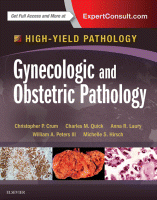Physical Address
304 North Cardinal St.
Dorchester Center, MA 02124

D efinition — Endometrium with both secretory and proliferative pattern glands. Clinical Features Epidemiology True mixed-pattern endometrium is relatively uncommon and can be attributed to four likely causes: 1. Hormonal imbalance (therapy) 2. Irregular ovulation 3. Defects in follicle development…

D efinition —Artifactual compression of glands during the biopsy process. Clinical Features Epidemiology Telescoping artifact is common and can be identified in a large proportion of endometrial biopsies. You’re Reading a Preview Become a Clinical Tree membership for Full access…

D efinition —An exaggerated response to unopposed estrogen but lacking the features of endometrial intraepithelial neoplasia (EIN) (atypical hyperplasia). Clinical Features Epidemiology Most commonly seen at or around menopause with failed ovulation and persistent follicle. Common in polycystic ovarian syndrome…

D efinition —Alterations in the endometrium due to lack of ovulation and estrogenic effects of a persistent follicle. Clinical Features Epidemiology Most commonly seen at or around menopause with failed ovulation and persistent follicle. Common in polycystic ovarian syndrome (PCOS).…

D efinition — Scheduled menstrual breakdown and abnormal stromal breakdown histologically mimicking adenocarcinoma. Clinical Features Epidemiology The presence of stromal breakdown within an endometrial biopsy is relatively common; fortunately, however, extensive breakdown, mimicking neoplasia, is relatively uncommon. You’re Reading a…

D efinition — Bleeding that occurs in the absence of ovulation and is not associated with an endometrial structural abnormality or other visible cause (fibroid or polyp). Clinical Features Epidemiology Dysfunctional uterine bleeding (DUB) is common, more frequently seen near…

D efinition — A polyp of the cervix composed of mature glial tissue. Clinical Features Epidemiology Extremely rare. Signifies retained glial tissue from a prior pregnancy based on genetic studies. Reproductive age group. You’re Reading a Preview Become a Clinical…

D efinition — A generally benign, peripheral nerve sheath tumor. Clinical Features Epidemiology Rare, limited to occasional case reports. Most reported cases—benign and malignant—occur in the third to eighth decades. You’re Reading a Preview Become a Clinical Tree membership for…

D efinition — A bi-patterned low-grade malignancy composed of neoplastic stroma admixed with benign but architecturally unique epithelial elements. Clinical Features Epidemiology Extremely rare; accounts for less than 2% of all müllerian adenosarcomas. Average age at presentation is 31 years,…

D efinition — A proliferation of specialized cuboidal cells derived from the squamocolumnar junction that gives rise to reserve cells, squamous metaplasia, and can harbor squamous intraepithelial lesions (SILs). Clinical Features Epidemiology Most commonly occurs in young women with an…